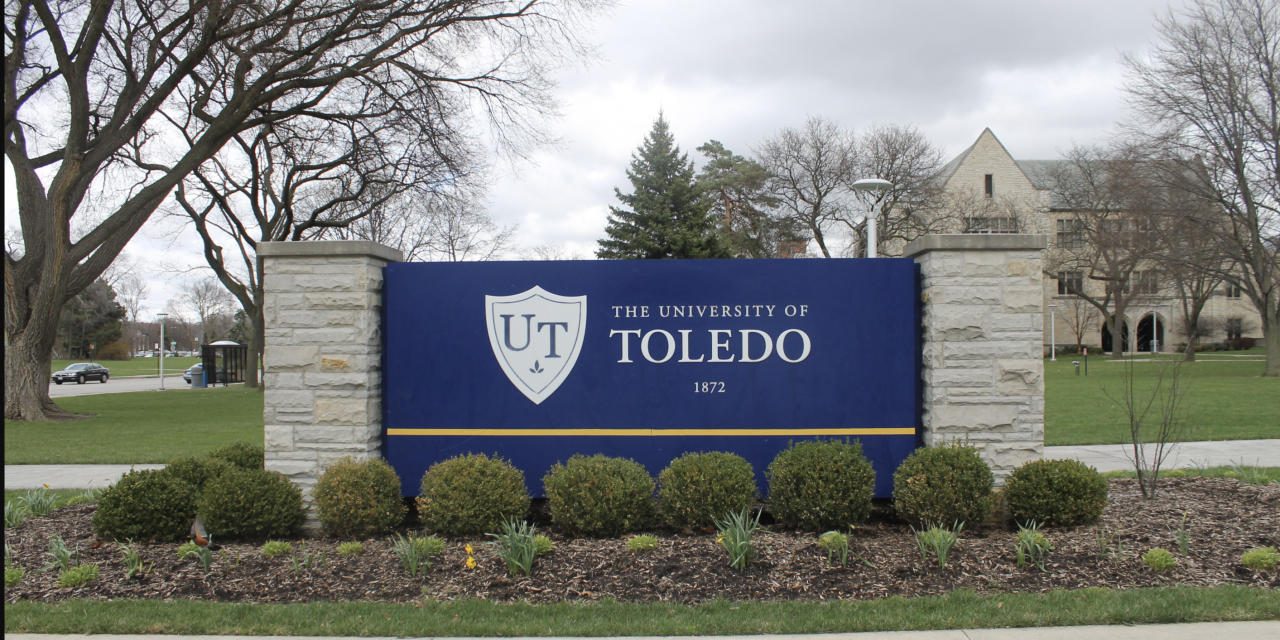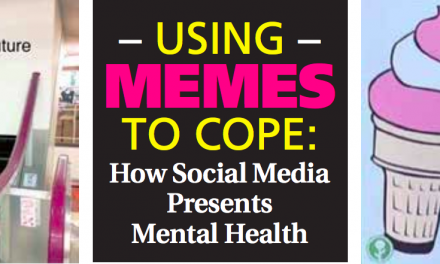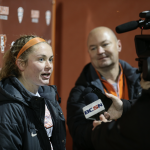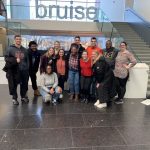Human
Trafficking
By Abby Shifley | Contributing Writer
Spring | 2020
The Human Trafficking and Social Justice Institute is located at the University of Toledo. Photo by Sarah North
“The biggest thing someone can do (to raise awareness of human trafficking) is not perpetuate these myths.” Human trafficking is one of the largest criminal activities in the world — but many people don’t know the most common ways it takes place @abbyshifley reports.
“The majority of all trafficking happens as a result of manipulation, in all reality, of vulnerable populations”
-Kristen Bishop, graduate intern at the Human Trafficking and Social Justice Institute at the University of Toledo
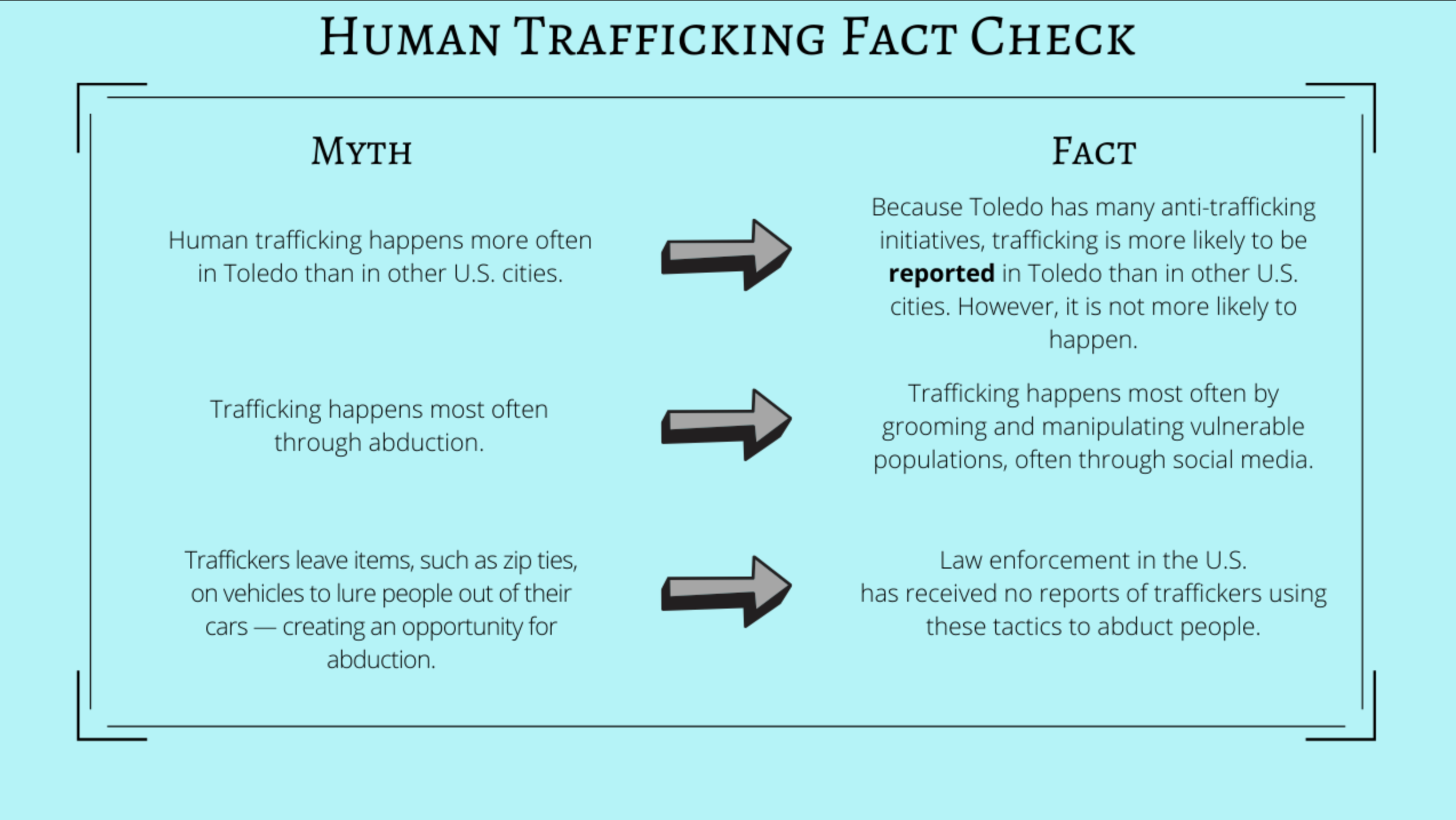
Human trafficking is the third-largest criminal activity in the world and is a form of human slavery that knows no demographic limitations, according to the FBI. However, many people don’t understand how trafficking happens.
Human traffickers are using social media to reach out to children who display emotional vulnerability online. Children who display these characteristics often want supportive and caring people in their lives, and traffickers feed off of this need, Kristen Bishop, graduate intern at the Human Trafficking and Social Justice Institute at the University of Toledo, said.
Since the internet is constantly changing, it is difficult to regulate and make safe for both children and adults.
“So being aware of your settings and who you’re talking to online is important for both the adults and youth involved,” Bishop said.
This use of online platforms means trafficking in northwest Ohio doesn’t happen in any one physical location but does happen more often in certain demographics.
“The majority of all trafficking happens as a result of manipulation, in all reality, of vulnerable populations,” Bishop said.
Certain characteristics make youth more at risk of being trafficked, including if they have run away from home or are homeless, struggle in school, have been involved in Child Protection Services or the juvenile court, live in poverty, are affiliated with gangs, are LGBTQ+, are born in another country, are a person of color or have disabilities.
Youth who are bullied also have a higher risk of being trafficked because they are typically emotionally vulnerable.
“Those youths are the most at risk, but they’re not exclusively at risk either,” Bishop said.
“Boyfriending” was a term Lara Lengel used to describe traffickers’ manipulation of youth. Lengel is a professor in the School of Media and Communication at BGSU who has researched human trafficking.
The term refers to when a trafficker or abuser acts like a young girl’s or boy’s boyfriend or girlfriend to gain their trust — but it is usually young women who are victims, Lengel said.
Another process similar to boyfriending is “grooming.” Through this grooming process, traffickers study young girls’ social media to determine whether the girls feel unloved or misunderstood. Then, the trafficker sends messages to prey on those characteristics, according to a study by the Research Subcommittee of the Ohio Attorney General’s Human Trafficking Commission.
The study describes grooming as traffickers focusing on “meeting needs of vulnerable youth by understanding their vulnerabilities, then exploiting them by filling the void and using that to transition the relationship into one of control.”
“It concerns me a lot because human beings want to be loved, right?” Lengel said. “And, so, whoever has come up with this notion of boyfriending — it’s genius, it’s awful, it’s awful genius, but very successful.”
There are many misconceptions about trafficking, Bishop said. Toledo has often been cited as No. 4 in the country for human trafficking, but, according to Bishop, Toledo’s rates of trafficking are no more or less than most cities in the U.S.
“The reason it’s so well known when it comes to trafficking is because of the advocates, the professionals that are dedicating their time and making policies and programs to fight it in Toledo,” Bishop said.
One article from the Ohio Department of Health stated Ohio and Toledo are high in human trafficking rankings. Bishop called this article “misleading” because it followed reported cases each year, and since Toledo has many anti-trafficking programs, people are more aware of the issue and, therefore, more likely to report their own cases of trafficking.
“That is why the article ranked Ohio and Toledo higher than other areas, not because one is more likely to be trafficked but because trafficking is more likely to be reported,” Bishop stated.
She also challenged other misgivings and stereotypes surrounding trafficking. Common myths include traffickers leaving zip ties on car side mirrors; or leaving roses, tags or other distracting objects on a person’s vehicle to entice them out — creating an opportunity for abduction.
“These are myths, so the biggest thing someone can do (to raise awareness of human trafficking) is not perpetuate these myths,” Bishop said.
When it comes to human trafficking, abduction does happen — but it’s rare.
A problematic, influential depiction of human trafficking is the movie “Taken” (2008), both Lengel and Bishop said. In the movie, Bryan Mills (Liam Neeson) is trying to reconnect with his estranged daughter when she is abducted into the sex industry while on vacation in Paris.
The film popularized the idea that trafficking happens most commonly through abduction, even though this idea is inaccurate. Human trafficking has many more components than abduction, and typically involves coercion and traffickers gaining victims’ trust.
Spreading general awareness in the public and ensuring the proper people are educated in identifying victims of trafficking are essential components to anti-trafficking efforts.
When it comes to identification, medical professionals can play a huge part in whether someone is rescued.
Victims of trafficking get hurt just like anyone else, and when they visit the hospital there might be a moment when a victim is able to interact with medical professionals without the presence of the person controlling them.
“So, if a practitioner would have an opportunity to ask someone who appears in whatever capacity to be at risk — ‘Do you feel safe at home or at work?’ That’s a really profound question. And depending on how that person responds, maybe there are follow up questions,” Lengel said.
Creative projects are another way to combat trafficking. Lengel had students in the play “Lily’s Wings,” now under the name “Free to Fly,” come perform a few scenes at a talk she gave. The play is performed by Bowling Green High School students and focuses on the issue of sex trafficking.
“Using your creativity and art can be a very good outlet for raising awareness or talking about somebody’s trauma. It is a completely different source of information,” Bishop said.
Bishop added that more information on community action against trafficking is available on the Ohio Attorney General’s map of trafficking coalitions in Ohio.
If you or someone you know is at risk of being trafficked, call the National Human Trafficking Resource Center at (888) 373-7888.
“These are myths, so the biggest thing someone can do (to raise awareness of human trafficking) is not perpetuate these myths”
– Kristen Bishop

